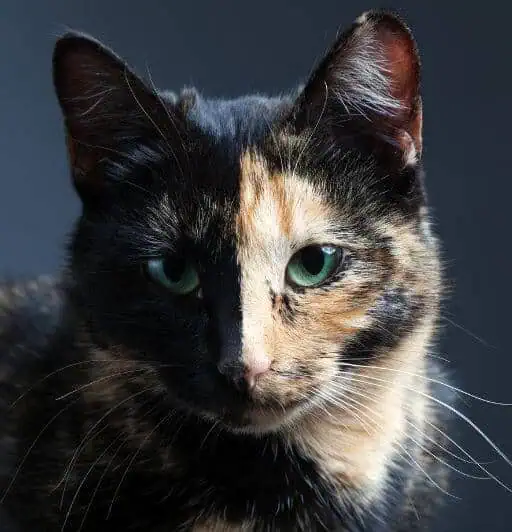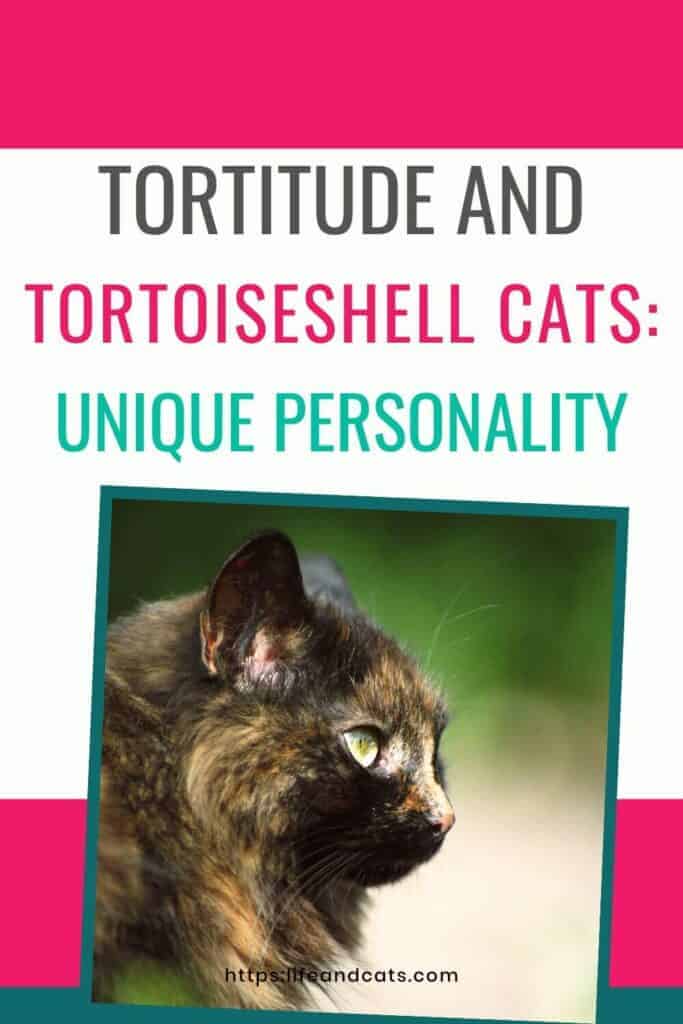Last Updated on April 17, 2024 by Holly Anne Dustin
Are you considering adopting a tortoiseshell cat? They are beautiful cats with a unique pattern and coloring. But they also have a reputation for being sassy, strong-willed, and potentially difficult, all summed up in the personality described as “Tortitude.” In this post we look at the traits, characteristics, personality and behaviors of tortoiseshell cats. Will a tortoiseshell cat be the perfect fit for your family, home and lifestyle?
Contents
Color and Patterns
The tortoiseshell cat is not a breed. It is a color and a pattern. You can get many breeds in the tortoiseshell color. The American Shorthair, British Shorthair, Burmese, the rex breeds – Cornish, Devon, and Selkirk, Japanese Bobtail, Maine Coon, Persian, Ragamuffin, Scottish Fold, and Turkish Angora all come in Tortoiseshell. There are even Torti-Point Ragdolls.
The basic tortoiseshell color is a combination of black and red/orange. The dilute is blue/gray and cream/gold. The mosaic patterns in tortie coats range from a salt and pepper, brindled pattern to a big, blotchy, patched pattern. If your kitty also shows a tabby pattern in her tortie colors, she’d be called a torbie.
Related Post: Cat Colors and Patterns
The most unique tortoiseshell pattern is the chimera. A chimera is a cat with one color on one side of the body and the other color on the other side. Usually these cats have a distinct black half and a distinct red half of their face. But you can see it on the rest of their body too.
Tortoiseshells can have any eye color. There isn’t a specific eye color associated with the tortoiseshell cat. So variations of the hazel, yellow, green, and amber seen in other cats will also be seen in tortie cats.Tortie-pointed cats will have the classic blue eyes of all pointed cats.

Genetics
So what creates this interesting and unique color pattern? Unlike other cats, tortoiseshell cats have a specific coat pattern that requires two X chromosomes. This means that only female cats can be tortoiseshell, as they have two X chromosomes. Male cats, who have one X and one Y chromosome, cannot have this coat pattern unless they have a rare genetic mutation. This mutation results in male cats with XXY Syndrome, who are often sterile and have health issues that can shorten their lifespan.
The inheritance of coat color in cats is complex and involves multiple genes. The color of a cat’s fur is determined by the type of pigment produced by melanocytes, which are specialized cells that produce melanin. There are two types of melanin: eumelanin, which produces black and brown colors, and pheomelanin, which produces red and orange colors.
Female tortoiseshell kittens inherit a gene for black fur from one parent and red fur from the other parent. During the kitten’s development, one X chromosome in every single cell deactivates but the process is random. Some cells produce red fur, and others the black fur resulting in the tortoiseshell pattern.
Health Challenges of the Tortoiseshell Cat
One of the most significant health concerns in tortoiseshell cats is Klinefelter Syndrome. This condition only affects male kittens. It can lead to developmental issues, behavioral problems, bones that break easily, and increased body fat that can contribute to diabetes and heart disease.
There are not any specific health problems associated with the tortoiseshell patterns for female kittens. To determine any health risks to your particular kitty you would want to look at the breeds that are behind your kitty. If you have a Persian, you’ll want to look at PKD. A Maine Coon would need to be screened for HCM and so on whatever their color or pattern.
A female tortoiseshell cat generally lives the typical 15-20 years you can expect from any well-cared for, indoor cat. The rare male tortie cat will likely live a shorter time due to the health problems caused by Klinefelter Syndrome.

Tortitude? The Unique Tortoiseshell Cat Personality
Tortoiseshell cats are the “divas” of cats. They are sassy, independent, and unpredictable. They like things done their way and can be aggressive and expressive when they don’t get it. Despite their strong-willed personality, they are very affectionate and loyal to their owners.
There is no specific science that links the color of a cat’s coat with their personality. After all, other variables such as gender and breed could impact the way a cat approaches the world. But there does seem to be some truth to the idea that tortie cats are indeed more “spicy.” I’ve seen it as a groomer, my most difficult clients are always torties. We see it in the cat show hall. All cats can be spicy; but it does seem like the tortoiseshells overreact more often. The judges often refer to tortitude or the spicy attitudes or the “red gene.” Veterinary professionals approach tortoiseshell cats with caution.
Researchers at the University of California-Davis vet school published a study in 2016 1Elizabeth A. Stelow, Melissa J. Bain & Philip H. Kass (2016) The Relationship Between Coat Color and Aggressive Behaviors in the Domestic Cat, Journal of Applied Animal Welfare Science, 19:1, 1-15, DOI: 10.1080/10888705.2015.1081820 about cat coat color and personality. The study surveyed over 1,200 cat owners about their cat’s personality and interactions with humans. The results support the idea that torties display challenging and aggressive behaviors more often than many other cat colors; but because of the limited survey size, and the fact that it was based on owner impressions, they are not conclusive.
The Tortoiseshell Cat In Myth And Legend
Despite their tortitude, tortie cats have a reputation for bringing good luck. They feature in myths and legends across time and cultures as bringers of fortune, protection, health, and love.
- The ancient Celts believed they brought good luck
- In Japan, the tortie cat is supposed to bring good luck and fortune. In another Japanese legend, the cat helps protect your home from ghosts.
- Ancient Egyptians also believe they will protect the home from evil.
- According to folklore from Southeast Asia, tortoiseshell cats were formed from the blood of a young goddess.
- If you dream of a tortoiseshell cat, you are supposedly destined to be lucky in love.
- A Norse fairytale connects the tortoiseshell cat with the three Norwegian Forest Cats that pull the goddess Freya’s chariot. Freya is the goddess of love, beauty and fertility. The cats are said to bring good luck in love and relationships.
- English folklore says rubbing a tortoiseshell cat’s tail on a wart will cure the affliction.
- In the United States, tortoiseshell cats are believed to be “money cats” that will bring good fortune and wealth.
Related: Want to Learn More About Breeds of Cats? Click on Our Directory Page Here
Conclusion
There are many things to consider when adopting a cat. You want to make a good match because you’ll be together for the next 12-15 years. Each cat is unique and the best match for your household depends on your own personality and compatibility with your new feline friend, no matter what their coat color. If you like a cat with a lot of spark and fire, a tortoiseshell cat might be for you. If you understand her unique personality, the Tortoiseshell cat can truly be a rewarding addition to your home.

I have been feeding a tortoise feral cat for 2 years. Some days she love’s my attention other days she hisses.
Jinx is a stereotypical Tortie. She knows what she wants and demands it. If she doesn’t get it promptly, the demanding will turn into being extremely vocal and even pawing/nipping to get your attention. However, if she doesn’t want your attention at any given time, she’ll happily let you know that too lol
She does sound exactly like what a tortie is supposed to be 🙂